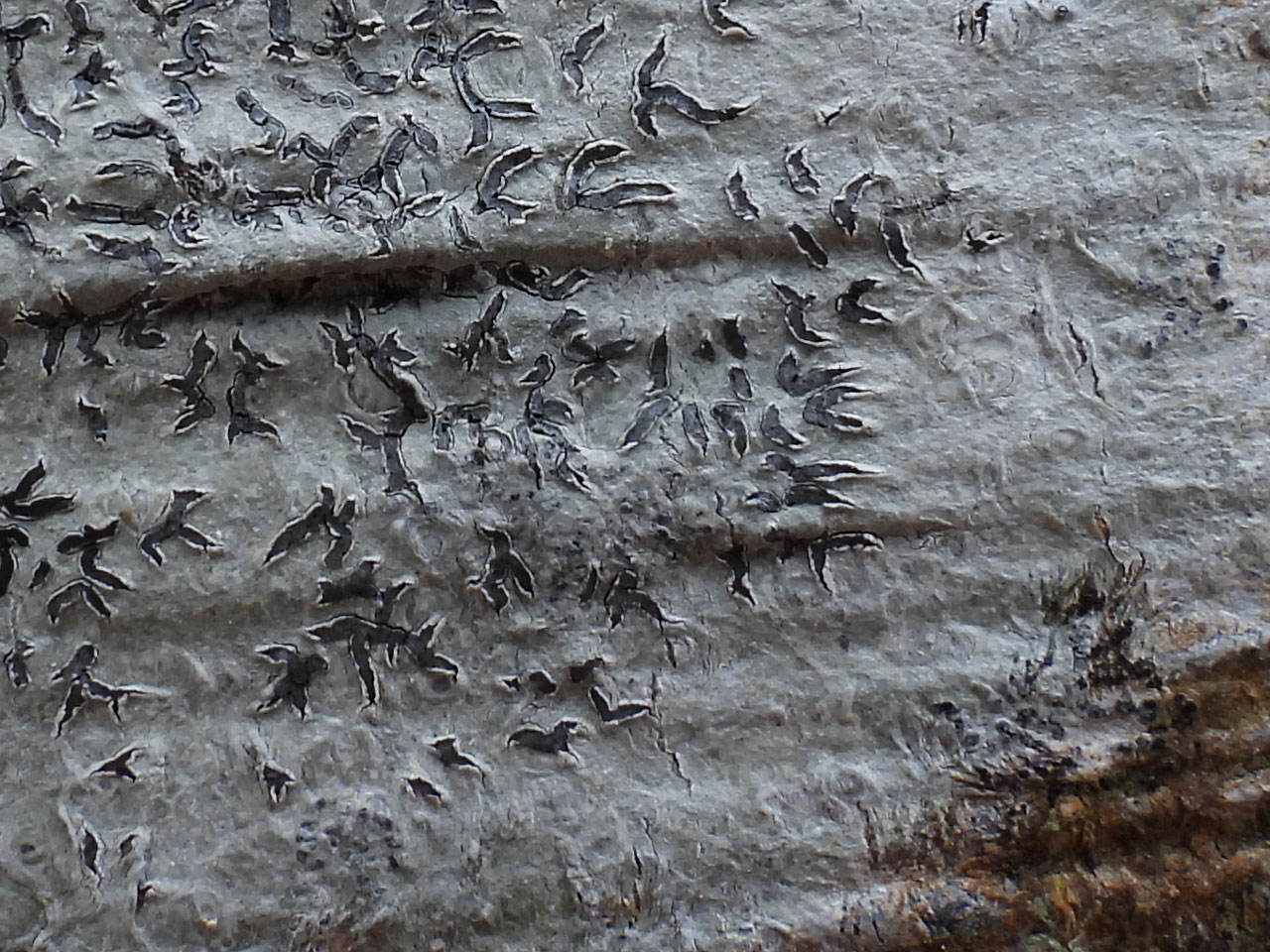Phaeographis dendritica
Well developed material forms a striking lichen on tree trunks, with the white thallus decorated with black thinly white pruinose branched and stellate lirellae radiating out. Smaller thalli are very similar to Phaeographis smithii but a vertical cut across the apothecia is sufficient to show the presence of dark tissue below the hymenium in P. dendritica. Found widely in the south west, mainly on trunks and older trees in woods, but also on twigs, but less so than P. smithii.
Thallus thin to moderately thick, wide-spreading or in patches, pale green-grey but sometimes tinged yellowish, often white-powdery, matt or glossy, smooth and even to cracked-areolate. Apothecia 0.5–3 × 0.3–0.5 mm, flat, ± level with the thallus, variable, scattered, elongate, straight, curved, stellate or dendritically branched; disc 0.15–0.3 mm wide, ends usually acute ± thinly white-pruinose; true exciple thin, entire, continuous below the hymenium; lateral walls 10–15 µm thick; hymenium 90–120 µm tall. Ascospores (26–) 30–40 (–45) × 6–9 µm, (5–) 7– to 9 (–10)-septate. Thallus C–, K+ yellow→red (crystals), KC+ red, Pd+ yellow to orange (reactions often patchy), UV– (norstictic and connorstictic acids).
The apothecia of P. dendritica are very variable, ranging from short and almost square in outline to branched and stellate; the disc is usually widely exposed. P. smithii can look very similar, but a vertical cut across the apothecia is sufficient to show the presence of excipular tissue below the hymenium in P. dendritica. This can be done on damp material in the field with a good lens (×20 best). Graphis inustuloides has narrower lirellae with a thalline rim, muriform ascospores, and a Pd– and K– thallus. Specimens of Graphis scripta s. lat. with shrivelled brown-walled ascospores have often been misidentified as P. dendritica. Graphis pulverulenta, is the most likely Graphis scripta s. lat. species to be confused with P. dendritica in macro characters.
Occasionally infected with ascomata of Stictographa lentiginosa which has small (0.1–0.5 × 0.1–0.2 mm), generally unbranched lirellae. Also host to Tremella phaeographidis Diederich et al. (1996), which produces brown, gall-like basidiomata on the thallus. Requiring further study are a taxon close to Arthonia graphidicola (in N. Cornwall), Lichenostigma cf. alpinum (R. Sant., Alstrup & D. Hawksw.) Ertz & Diederich (2013) and Taeniolella cf. hawksworthiana Heuchert et al. (2016), the latter may be an anamorph of Stictographa lentiginosa.
On the bark of deciduous trees and shrubs in moderate shade and more typical of trunks and old trees than P. smithii; locally frequent.

S.W. Britain, extending along the south coast, and throughout Ireland. There is probably some over-recording in the northern edges of its range. The single confirmed record from W. Scotland is on a Rhododendron plant that was apparently introduced from S.W. England.
A locally frequent species in the south west, most frequent in older woods, but colonising to young woodlands quite rapidly within its core area. Included within the Southern Oceanic Woodland Indicator list.
Scotland: Priority Taxon for Biodiversity in Scotland
Aptroot, A., Weerakoon, G., Cannon, P., Coppins, B., Sanderson, N. & Simkin, J. (2023). Ostropales: Graphidaceae, including the genera Allographa, Clandestinotrema, Crutarndina, Diploschistes, Fissurina, Graphis, Leucodecton, Phaeographis, Schizotrema, Thelotrema and Topeliopsis. Revisions of British and Irish Lichens 36: 1-23.
Text by Neil A Sanderson based on Aptroot et al (2023)







